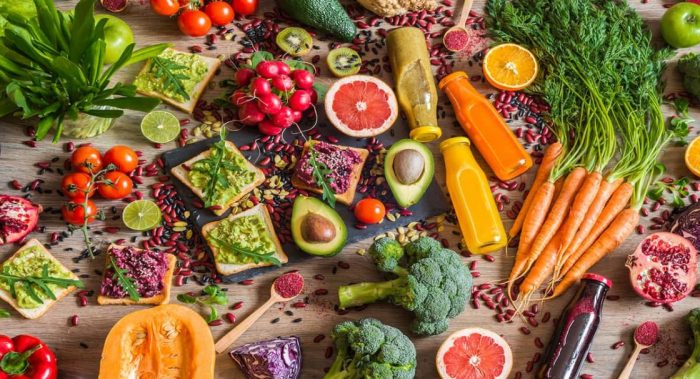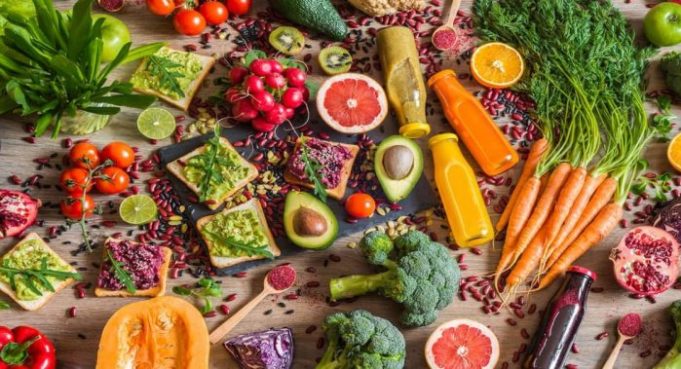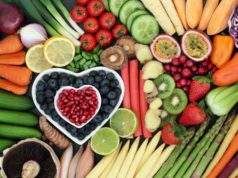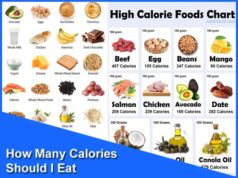How to start a vegan diet is a question many ask, intrigued by the ethical, environmental, and health benefits it offers. This guide serves as your roadmap, navigating you through the world of plant-based eating with a blend of practical advice, nutritional insights, and delicious recipes. Embark on this journey with us, and discover a world of vibrant flavors, sustainable choices, and a healthier you.
We’ll delve into the core principles of veganism, explore various types of vegan diets, and Artikel the key nutrients to prioritize. We’ll provide practical tips for transitioning smoothly, offer a week-long sample meal plan, and guide you through the social and culinary aspects of vegan living. By the end, you’ll be equipped with the knowledge and resources to embrace a fulfilling vegan lifestyle.
Understanding Veganism
Veganism is a lifestyle that involves abstaining from all animal products, including meat, dairy, eggs, and honey. It is rooted in ethical, environmental, and health concerns.
Ethical Considerations
Veganism promotes compassion for animals and recognizes their inherent right to life and freedom from exploitation. It opposes animal agriculture, which involves the raising and slaughtering of animals for food, clothing, and other products.
Environmental Impact
Animal agriculture is a major contributor to environmental problems such as deforestation, greenhouse gas emissions, water pollution, and biodiversity loss. Veganism aims to minimize these impacts by reducing the demand for animal products.
Health Benefits
Vegan diets are typically rich in fruits, vegetables, legumes, and whole grains, which are associated with a lower risk of chronic diseases such as heart disease, stroke, type 2 diabetes, and certain types of cancer. Vegan diets are also often lower in saturated fat and cholesterol and higher in fiber, which can contribute to weight management and improved cholesterol levels.
Types of Vegan Diets
There are various types of vegan diets, each with its own focus and nutritional approach.
Whole-Food Plant-Based Diets
Whole-food plant-based diets emphasize minimally processed, unrefined plant foods such as fruits, vegetables, legumes, whole grains, nuts, and seeds. They typically avoid processed foods, refined oils, and added sugars.
Low-Fat Vegan Diets
Low-fat vegan diets restrict fat intake, focusing on low-fat plant foods like fruits, vegetables, and legumes. These diets are often associated with weight loss and improved cardiovascular health.
High-Protein Vegan Diets
High-protein vegan diets aim to meet protein needs through plant-based sources such as legumes, tofu, tempeh, seitan, and nuts. These diets are often chosen by athletes or individuals looking to build muscle mass.
Planning Your Vegan Journey: How To Start A Vegan Diet
Embarking on a vegan lifestyle is a rewarding journey that involves making conscious choices about your food and lifestyle. Transitioning gradually, while ensuring a balanced intake of essential nutrients, is key to a successful and sustainable vegan experience.
Gradual Transition
Starting your vegan journey doesn’t require an immediate and drastic overhaul of your diet. A gradual transition allows your body to adjust and helps you explore new flavors and recipes at your own pace. Here’s a practical approach:
- Start with one meal a day: Begin by replacing one meal, like breakfast or lunch, with a vegan option. This will help you get familiar with plant-based cooking and adjust your taste buds.
- Eliminate one animal product at a time: Instead of trying to eliminate all animal products at once, focus on gradually removing one category, like dairy or eggs, before moving on to the next.
- Experiment with new recipes: Don’t be afraid to try new vegan recipes and explore different cuisines. There’s a vast world of delicious and creative plant-based dishes to discover.
- Seek support: Connect with other vegans, join online communities, or consult with a registered dietitian specializing in plant-based nutrition. They can offer valuable guidance and support throughout your transition.
Essential Vegan Foods
A well-planned vegan diet should include a variety of foods from different food groups to ensure you’re getting all the essential nutrients your body needs.
Fruits
Fruits are rich in vitamins, minerals, fiber, and antioxidants. They provide natural sweetness and are a delicious way to start your day or enjoy a healthy snack.
- Berries: Blueberries, strawberries, raspberries, blackberries
- Citrus fruits: Oranges, grapefruits, lemons, limes
- Tropical fruits: Bananas, mangoes, pineapples, papayas
- Apples, pears, grapes, peaches, melons
Vegetables
Vegetables are packed with vitamins, minerals, fiber, and antioxidants. They are essential for overall health and well-being.
- Leafy greens: Spinach, kale, collard greens, romaine lettuce
- Cruciferous vegetables: Broccoli, cauliflower, Brussels sprouts, cabbage
- Root vegetables: Carrots, potatoes, sweet potatoes, beets
- Other vegetables: Tomatoes, peppers, onions, garlic, zucchini, mushrooms, asparagus
Grains
Grains provide complex carbohydrates, fiber, and some vitamins and minerals. Whole grains are more nutritious than refined grains.
- Whole grains: Brown rice, quinoa, oats, barley, whole wheat bread
- Refined grains: White rice, white bread, pasta
Legumes
Legumes are excellent sources of protein, fiber, iron, and other essential nutrients. They are versatile and can be used in various dishes.
- Beans: Kidney beans, black beans, chickpeas, lentils, pinto beans
- Peas: Green peas, split peas
Nuts and Seeds
Nuts and seeds are rich in protein, healthy fats, fiber, and vitamins and minerals. They make a great snack or can be added to salads, smoothies, and other dishes.
- Nuts: Almonds, cashews, walnuts, peanuts, pecans
- Seeds: Chia seeds, flax seeds, sunflower seeds, pumpkin seeds, hemp seeds
Sample Vegan Meal Plan
Here is a sample vegan meal plan for a week, incorporating a variety of recipes and ensuring adequate nutritional content. This plan provides a general guideline, and you can adjust it based on your individual needs and preferences.
Monday
- Breakfast: Oatmeal with berries and nuts
- Lunch: Lentil soup with whole wheat bread
- Dinner: Tofu stir-fry with brown rice and vegetables
Tuesday
- Breakfast: Smoothie with fruit, spinach, and almond milk
- Lunch: Chickpea salad sandwich on whole wheat bread
- Dinner: Vegan chili with cornbread
Wednesday
- Breakfast: Vegan pancakes with fruit and maple syrup
- Lunch: Salad with chickpeas, quinoa, and vegetables
- Dinner: Vegan pasta with marinara sauce and vegetables
Thursday
- Breakfast: Toast with avocado and tomato
- Lunch: Black bean burgers with sweet potato fries
- Dinner: Vegan pizza with vegetables and vegan cheese
Friday
- Breakfast: Fruit salad with yogurt
- Lunch: Leftovers from Thursday’s dinner
- Dinner: Vegan tacos with black beans, salsa, and avocado
Saturday
- Breakfast: Waffles with fruit and syrup
- Lunch: Vegan burritos with brown rice, beans, and vegetables
- Dinner: Vegan curry with rice
Sunday
- Breakfast: Scrambled tofu with toast
- Lunch: Vegan soup with bread
- Dinner: Vegan lasagna with vegetables
Essential Nutrients for Vegans

A vegan diet can provide all the nutrients your body needs, but it requires careful planning and attention to specific nutrients. Some essential nutrients, like vitamin B12, iron, calcium, and omega-3 fatty acids, are less abundant in plant-based foods compared to animal products. Therefore, it is crucial to understand how to obtain these nutrients effectively on a vegan diet.
Sources of Vitamin B12
Vitamin B12 is essential for cell growth, red blood cell formation, and nerve function. It is not naturally found in plant-based foods, so supplementation is generally recommended for vegans.
- Supplementation: Vitamin B12 supplements are readily available in various forms, including tablets, gummies, and sprays. The recommended daily intake is 2.4 mcg for adults.
- Fortified Foods: Some plant-based foods are fortified with vitamin B12, such as nutritional yeast, plant-based milk, and cereals. Check product labels for vitamin B12 content.
Sources of Iron
Iron is essential for oxygen transport in the blood and energy production. Plant-based sources of iron are generally less bioavailable than animal sources.
- Iron-Rich Plant Foods: Lentils, beans, tofu, spinach, and fortified cereals are good sources of iron. Consuming iron-rich foods with vitamin C-rich foods, such as citrus fruits, tomatoes, and bell peppers, can enhance iron absorption.
- Supplementation: Iron supplements may be necessary if dietary intake is insufficient. Consult with a healthcare professional for personalized recommendations.
Sources of Calcium, How to start a vegan diet
Calcium is crucial for strong bones, teeth, and muscle function.
- Calcium-Rich Plant Foods: Tofu, leafy green vegetables (kale, collard greens), fortified plant-based milk, and almonds are excellent sources of calcium.
- Supplementation: Calcium supplements are readily available if dietary intake is inadequate. Consult with a healthcare professional for personalized recommendations.
Sources of Omega-3 Fatty Acids
Omega-3 fatty acids are essential for brain function, heart health, and reducing inflammation. While they are found in some plant-based foods, the amounts are lower than in fatty fish.
- Plant-Based Sources: Flaxseeds, chia seeds, walnuts, and seaweed are good sources of ALA (alpha-linolenic acid), a plant-based omega-3 fatty acid. The body can convert ALA into EPA and DHA, but the conversion rate is limited.
- Supplementation: Algae-based omega-3 supplements provide EPA and DHA directly, which are more readily absorbed by the body.
Nutrient Comparison Table
| Nutrient | Vegan Sources | Non-Vegan Sources |
|---|---|---|
| Vitamin B12 | Fortified foods (nutritional yeast, plant-based milk, cereals), supplements | Meat, poultry, fish, eggs, dairy products |
| Iron | Lentils, beans, tofu, spinach, fortified cereals | Meat, poultry, fish, eggs |
| Calcium | Tofu, leafy green vegetables, fortified plant-based milk, almonds | Dairy products, fortified orange juice |
| Omega-3 Fatty Acids | Flaxseeds, chia seeds, walnuts, seaweed | Fatty fish (salmon, tuna, mackerel), eggs |
Exploring Vegan Cuisine
One of the most exciting aspects of embracing a vegan lifestyle is the opportunity to discover a world of delicious and diverse cuisine. Veganism isn’t just about what you don’t eat; it’s about embracing a whole new range of flavors, textures, and culinary traditions.
Popular Vegan Dishes from Around the World
Vegan cuisine is found in every corner of the globe, showcasing the incredible creativity and adaptability of plant-based cooking. Here are some examples of popular vegan dishes from different cultures:
- Indian: Samosas (savory pastries filled with potatoes and peas), Chana Masala (chickpea curry), Aloo Gobi (potato and cauliflower curry), Dal Makhani (lentil stew).
- Japanese: Miso Soup (a flavorful broth with tofu and seaweed), Edamame (steamed soybeans), Tempura Vegetables (deep-fried vegetables), Sushi (with vegan fillings like avocado, cucumber, and pickled ginger).
- Thai: Pad Thai (stir-fried rice noodles with tofu, vegetables, and peanut sauce), Green Curry (coconut milk curry with vegetables), Tom Kha Gai (coconut soup with mushrooms and lemongrass).
- Mexican: Tofu Tacos (with various fillings like beans, vegetables, and salsa), Enchiladas (corn tortillas filled with vegetables and beans), Quesadillas (grilled tortillas with vegan cheese and fillings).
- Italian: Pasta with Pesto (a sauce made with basil, pine nuts, and olive oil), Pizza Margherita (with tomato sauce, vegan mozzarella, and basil), Risotto with Mushrooms (a creamy rice dish).
Vegan Recipes by Meal Type
Vegan recipes are readily available online and in cookbooks, offering a wide range of options to suit every taste and preference. Here’s a categorization of vegan recipes by meal type:
Breakfast
- Oatmeal: With fruits, nuts, and seeds for a nutritious start to the day.
- Smoothies: Packed with fruits, vegetables, and plant-based protein powder.
- Tofu Scramble: A savory breakfast option that mimics scrambled eggs.
- Vegan Pancakes: Made with plant-based milk and flour.
- Breakfast Burritos: Filled with tofu, beans, vegetables, and salsa.
Lunch
- Salads: With a variety of fresh vegetables, legumes, and a flavorful dressing.
- Sandwiches: On whole-wheat bread with vegan cheese, hummus, and vegetables.
- Soup: A hearty and filling option, especially during colder months.
- Wraps: Filled with tofu, beans, vegetables, and hummus.
- Buddha Bowls: A colorful and nutritious combination of grains, vegetables, and legumes.
Dinner
- Pasta Dishes: With a variety of vegan sauces, vegetables, and tofu.
- Curries: Flavorsome and satisfying, using coconut milk, vegetables, and legumes.
- Stir-Fries: Quick and easy to prepare, with a variety of vegetables and tofu.
- Pizza: With a vegan crust and toppings like vegetables, vegan cheese, and plant-based meats.
- Roasted Vegetables: A simple and flavorful way to enjoy vegetables.
Snacks
- Fruits and Vegetables: Nature’s perfect snacks, packed with vitamins and minerals.
- Nuts and Seeds: A great source of healthy fats, protein, and fiber.
- Hummus: A delicious and versatile dip, perfect with crackers, vegetables, or bread.
- Trail Mix: A combination of nuts, seeds, and dried fruit.
- Vegan Protein Bars: A convenient and portable snack option.
Desserts
- Fruit-Based Desserts: Fresh fruit, fruit salads, and fruit pies.
- Vegan Chocolate: Made with plant-based milk and cocoa powder.
- Vegan Ice Cream: Made with coconut milk, almond milk, or soy milk.
- Vegan Cookies: Using plant-based butter and milk alternatives.
- Vegan Cakes: Made with plant-based ingredients like applesauce or mashed bananas.
Visual Representation of a Vegan Meal Plan
A balanced vegan meal plan includes a variety of foods from different food groups to ensure you’re getting all the essential nutrients. Here’s a visual representation:
[Image description: A plate divided into four sections, each representing a food group. The first section is labeled “Fruits & Vegetables” and features a colorful array of fruits and vegetables. The second section is labeled “Grains & Legumes” and includes brown rice, quinoa, lentils, and chickpeas. The third section is labeled “Nuts & Seeds” and showcases almonds, walnuts, pumpkin seeds, and sunflower seeds. The fourth section is labeled “Plant-Based Protein” and features tofu, tempeh, and seitan.]
Embracing a Vegan Lifestyle
Going vegan is not just about food; it’s a holistic lifestyle choice with far-reaching positive impacts. Beyond the nutritional benefits, a vegan lifestyle promotes environmental sustainability, animal welfare, and personal well-being.
The Positive Impacts of a Vegan Lifestyle
A vegan lifestyle goes beyond dietary choices, encompassing ethical, environmental, and personal well-being aspects.
Environmental Sustainability
A plant-based diet has a significantly lower environmental footprint compared to a diet rich in animal products.
- Reduced Greenhouse Gas Emissions: Animal agriculture is a major contributor to greenhouse gas emissions, particularly methane, which is a far more potent heat-trapping gas than carbon dioxide. By reducing or eliminating animal product consumption, vegans can significantly reduce their carbon footprint.
- Conservation of Water Resources: The production of meat, dairy, and eggs requires vast amounts of water. For example, producing one pound of beef requires approximately 1,800 gallons of water, while producing one pound of wheat requires only 25 gallons. By adopting a vegan diet, individuals can contribute to conserving precious water resources.
- Protection of Biodiversity: Animal agriculture is a leading driver of deforestation and habitat loss, threatening biodiversity. By choosing plant-based options, vegans can help protect ecosystems and support the preservation of endangered species.
Animal Welfare
Veganism is rooted in the belief that all living beings deserve to be treated with compassion and respect.
- Ending Factory Farming: Factory farms, where animals are confined to cramped spaces and subjected to inhumane conditions, are a major concern for animal welfare advocates. By choosing a vegan lifestyle, individuals can contribute to reducing the demand for factory-farmed products, thereby minimizing animal suffering.
- Promoting Cruelty-Free Practices: Veganism extends beyond food to encompass all aspects of life, including clothing, cosmetics, and household products. By choosing cruelty-free alternatives, vegans can support companies that do not test on animals or use animal-derived ingredients.
Personal Well-being
A vegan lifestyle can have numerous positive impacts on personal well-being.
- Improved Health: Studies have shown that vegans tend to have lower rates of chronic diseases such as heart disease, type 2 diabetes, and certain types of cancer. A plant-based diet is rich in fruits, vegetables, and whole grains, which provide essential nutrients and antioxidants that promote overall health.
- Increased Energy Levels: A vegan diet is often associated with increased energy levels. Plant-based foods are typically easier to digest than animal products, which can lead to improved digestion and better nutrient absorption.
- Enhanced Mental Clarity: A vegan lifestyle can contribute to enhanced mental clarity and focus. The nutrients found in plant-based foods, such as omega-3 fatty acids and B vitamins, are essential for brain health and cognitive function.
Ultimate Conclusion
Embracing a vegan diet is a journey of self-discovery, a commitment to ethical living, and a celebration of plant-based goodness. With careful planning, informed choices, and a dash of creativity, you can enjoy a vibrant and fulfilling vegan lifestyle. Remember, every step you take towards a plant-based diet is a step towards a healthier planet, a more compassionate world, and a happier you.
Essential Questionnaire
What are some common misconceptions about veganism?
A common misconception is that vegan diets are restrictive or lack essential nutrients. With proper planning, vegan diets can provide all the nutrients you need. Another misconception is that vegan food is bland or boring. The reality is that vegan cuisine is incredibly diverse and flavorful, with countless delicious dishes to explore.
Is it expensive to follow a vegan diet?
The cost of a vegan diet can vary depending on your choices. While some vegan foods can be pricier, many staples like beans, lentils, rice, and vegetables are affordable. You can also save money by cooking at home and choosing seasonal produce.
How can I make sure I’m getting enough protein on a vegan diet?
Plant-based foods are excellent sources of protein. Include legumes, tofu, tempeh, nuts, seeds, and quinoa in your diet. A balanced and varied vegan diet will easily meet your protein needs.
How do I find vegan restaurants and options when dining out?
Many restaurants now offer vegan options, and some are even entirely vegan. Use online resources like HappyCow or VegGuide to find vegan-friendly eateries near you. When dining out, don’t hesitate to ask about vegan options or modifications to existing dishes.
Starting a vegan diet can be a great way to improve your health and well-being, and it can also be a great way to manage your weight. If you’re looking to lose weight, you might want to consider incorporating some of the principles of the best diet to lose weight for diabetics into your vegan diet.
This approach emphasizes whole, unprocessed foods and can be a helpful tool for managing blood sugar levels and losing weight. Remember, it’s important to consult with a healthcare professional before making any significant dietary changes.
Starting a vegan diet can be a great way to improve your health and reduce your environmental impact. You’ll need to plan meals carefully to ensure you’re getting all the nutrients your body needs. There are many different approaches to veganism, and it can be helpful to research the various types of diets to lose weight to find one that suits your lifestyle.
Remember, a well-planned vegan diet can be a delicious and sustainable way to achieve your health goals.
Switching to a vegan diet can be a great way to improve your health and reduce your environmental impact. One important aspect of a vegan diet is ensuring you get enough fiber, which is crucial for digestive health and overall well-being.
If you’re struggling to get enough fiber in your vegan diet, check out this helpful guide on how to get more fiber in your diet. By incorporating plenty of fiber-rich plant-based foods like fruits, vegetables, legumes, and whole grains, you can ensure a balanced and healthy vegan diet.
























